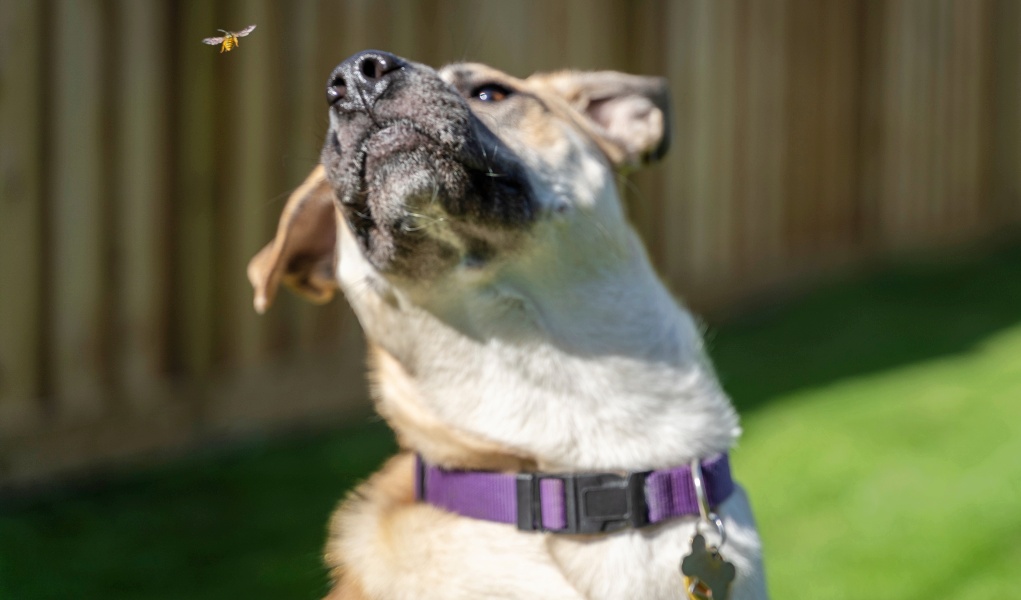I always feel so bad for my dogs when they are stung or bitten by hurtful bugs. I live in Maine, and we have large flies, mosquitos, wasps, hornets and many other bugs that will sting/bite our pets from time to time. Learning what to do if your dog is stung by a bee is first aid knowledge that every pet owner should have.
The canine body's reaction to a bee sting is the same as that of a humans. Bee stings will cause redness, inflammation and pain. Since dogs explore the world with their noses, they are often stung on the nose or face. It can cause quite a panic if your dog's face swells up and you don't know what to do about it.
Sometimes bee stings and insect bites can be overwhelming for you and your pup. If your dog steps on a ground nest or disturbs an anthill, the pests may swarm his body and sting him multiple times. If this happens, you should rush your dog to the veterinarian to be checked out.
Insect venom can cause serious health problems, and multiple bites/stings need to be treated as soon as possible. Your dog could also go into shock quickly after being attacked. DO NOT wait and try to treat multiple stings at home. Call your veterinarian to let them know you're coming, and be on your way as soon as possible.
What To Do If Your Dog Is Stung by A Bee?
The first thing you need to do when learning what to do if your dog is stung by a bee is to actually realize when your pet has been stung. If you notice your dog pawing at his face, chewing on his paw or acts like he's pain at all, check the area for a sting. If your dog has been stung, here are the steps you'll need to take:
1. What stung your dog?
Once you've realized that your dog has been stung, you need to figure out what stung him. Check the area for nests or insects that may have attacked your pet. If you're unsure of what the animal is, capture it. For example, if you believe that a spider has bitten your dog and you can't identify the species, be sure to capture it for identification purposes later on.
2. Remove the stinger
If your dog has been stung, you'll need to remove the stinger. Use a credit card to scrape across your dog’s skin and push the stinger out. Using tweezers could cause more pain. It will also inject more venom from the stinger into your pet's body.
3. Soothe the area
Soothe the sting wound with a thick paste of baking soda and water. If your dog was stung multiple times, it may be easier to give him a soothing bath. Fill the bathtub with about 6 inches of warm water and add 4 cups of oatmeal.
Try to get your dog to lie down in the water. If he won't lie down, pour the water over him with a cup or bowl. Continue to pour water over him for at least 20 minutes. This will allow it to really soak through his coat and have time to soothe the stings. DO NOT try to work the water through his coat with your hands, as touching the affected areas may be painful.
4. Reduce swelling if possible
Try to reduce any swelling by applying an ice pack (or bag of frozen vegetables) to the affected area for 10 minutes. You can leave the baking soda paste on while you’re applying the ice pack. Do not apply the ice pack directly to the skin. Use a thin towel or layer of paper towels to protect the skin from getting too cold.
Now that you've removed the stinger and done as much as you can to soothe area, you'll need to call your veterinarian. Let them know what happened and how your dog's body reacted to the sting. They may recommend giving your dog an oral antihistamine to prevent an allergic reaction, but NEVER give your dog medication without being directed to do so by your veterinarian.
Be diligent about preventing your dog from licking or scratching the area. This will only irritate the area even more. An e-collar may be needed for the first few hours after the sting to prevent your dog from accessing the area.
READ NEXT: Ant Bites in Dogs – Symptoms, Treatments and Prevention













